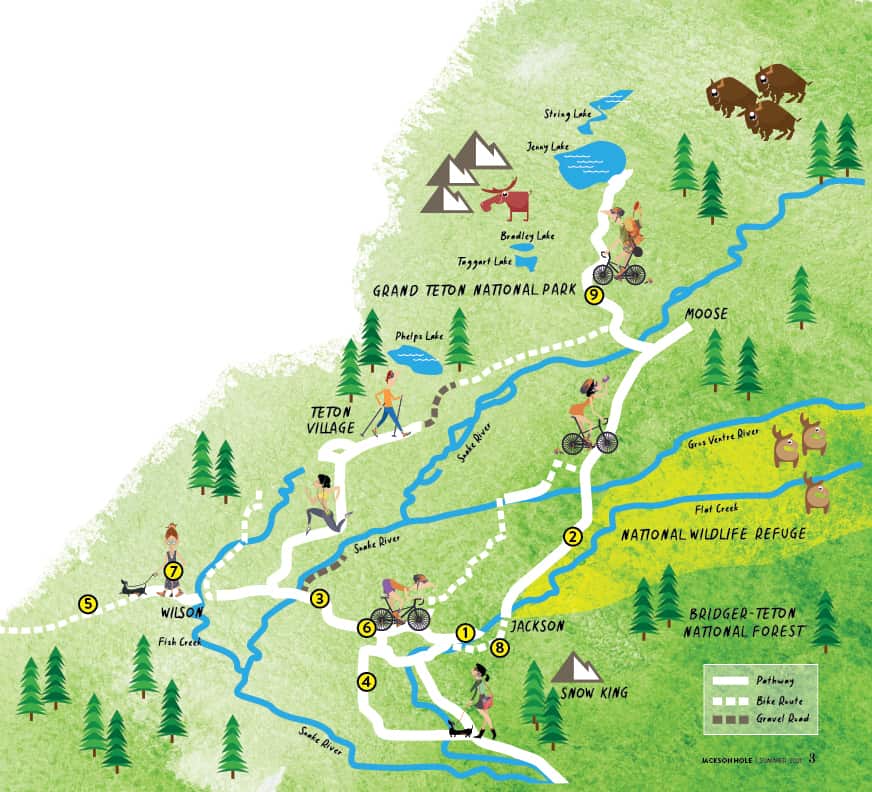Read The
Current Issue
// by maggie Theodora // Illustration by elise mahaffie
Today the Jackson Hole pathways system includes more than twenty-seven miles of paved shared-use paths and twenty miles of sidewalks. There are also pathways in Grand Teton National Park (GTNP). It is possible for cyclists and pedestrians to get from the east side of the valley to the west side and from downtown Jackson to GTNP while being separated from cars. “Our pathways definitely distinguish us from many other similar mountain communities,” says Katherine Dowson, executive director of the non-profit group Friends of Pathways. This robust pathway system didn’t happen overnight, though. Talk of integrating bicyclists and pedestrians into the valley’s transportation plan started in 1990. After working on a comprehensive county pathways plan as a volunteer for a couple of years, Tim Young was hired part-time in 1992 as the first pathways director, a position he held until 2002. The valley’s first pathway opened in 1996. “We’re so fortunate with our pathway system,” Dowson says. “I don’t ride my bike anywhere but pathways. My kids don’t even know what it means to share a road with traffic.”

1. Named for the deceased son of former Jackson mayor Abi Garaman, the Russ Garaman Trail was the first pathways section to be built. Opened in 1996, it was financed in part by a bequest from Russ’s estate and today is one of the most used sections of the system. “It was incredibly challenging, but we knew this was the best way to get our pathways started. We needed something that was big enough to be meaningful, but small enough that we might get it done,” says Young.
2. According to Brian Schilling, Jackson Hole Community Pathways coordinator, the pathway from Jackson to the Gros Ventre River, which goes through the National Elk Refuge, required the highest level of environmental analysis and planning—more than any other stretch of pathway. “It is a pathway on a national wildlife refuge, and there was a significant amount of collaboration and teamwork between the county and the U.S. Fish and Wildlife Service,” he says.
3. The Stilson Ranch to Emily’s Pond section of the longer Path 22along WY Highway 22 is short but was the most expensive piece to build because it includes two major structures, the tunnel under WY390 and a 770-foot-long bridge over the Snake River. A steel girder bridge design was used here (rather than the steel truss bridge that spans the Gros Ventre River on the north pathway) because it allowed for a lower profile.
4. Look for how the pathway along South Park Loop Road was constructed to allow for the movement of wildlife, including gaps in retaining walls. “If animals want to move through an area, you don’t want to make them go out of their way to go around a retaining wall,” Schilling says.
5. With the major skeletal components of the valley’s pathways system in place, “We’re now focusing on filling in shorter missing links that make connections to neighborhoods and destinations that are currently disconnected from the system, like the south side of WY22,” Schilling says. “People who live here can see the pathway but can’t get there safely because WY22 is a major barrier.”
6. The murals in pathway tunnels are done in collaboration with JH Public Art. Some are painted by professional artists; others are done by art classes at various valley schools. The tunnels by Skyline Ranch and under WY390 feature new murals this summer.
7. “It was epic to get approval,” says Young about the Wilson Centennial Trail. To make it happen, he worked with the Jackson Hole Land Trust and the Jackson Hole Mountain Resort to get easements and protect open space. The pond next to the pathway near Wilson Elementary School was originally a cow pasture. “We excavated the pond and used that fill to build the base of the pathway,” Young says.
8. “The bollards on Snow King Avenue are a temporary and imperfect way of separating bike and foot traffic in an area where it is not practical to do a separated pathway,”Schilling says.
9. In GTNP, part of the pathway between Moose and Jenny Lake honors Gabriella Axelrad, who was struck by a van and killed at age thirteen in July 1999 while cycling in the park with her family. There was not a pathway in the park yet; GTNP’s first pathway opened in 2009. JH




